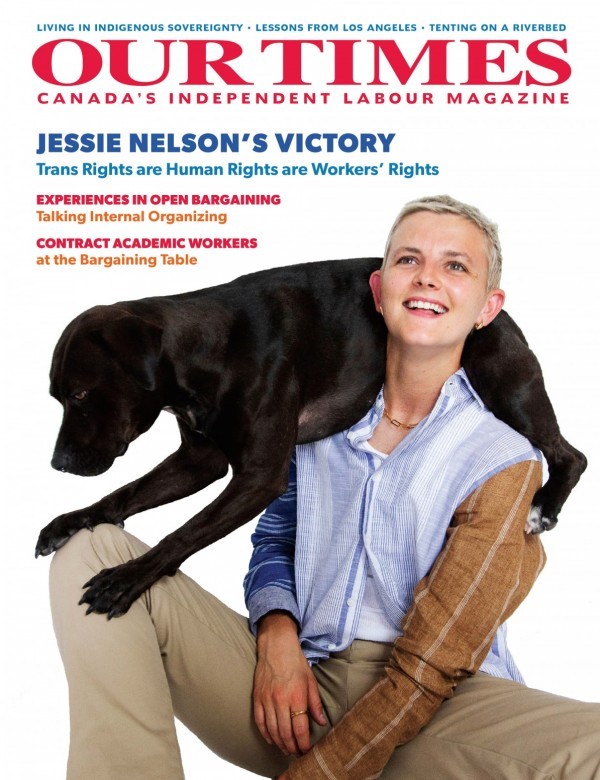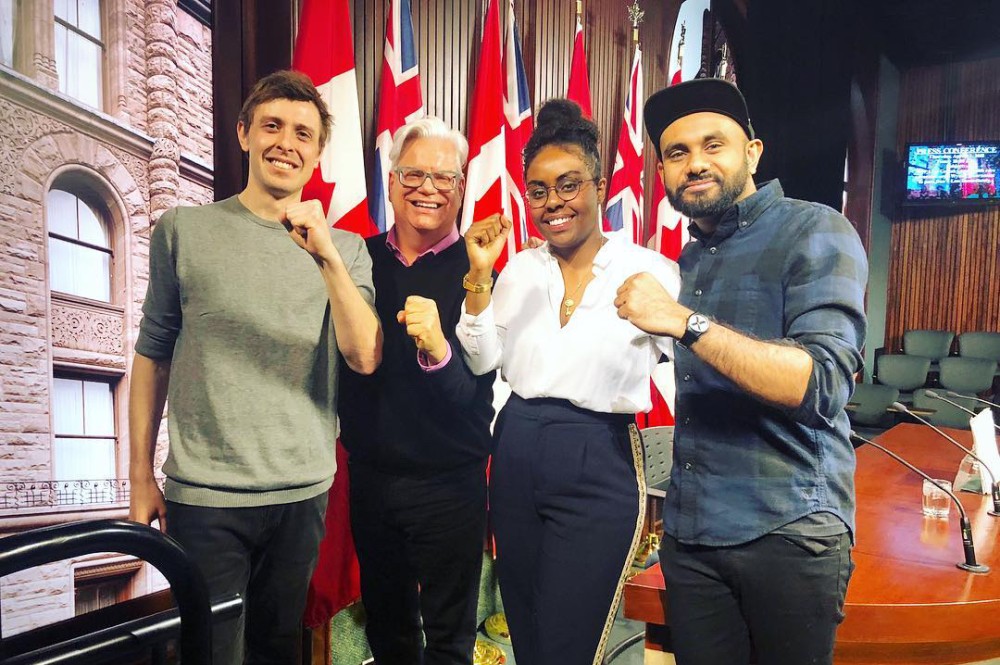Collective bargaining is a way for union members to be heard in negotiations with employers. But is there a need to ensure more members’ voices are part of the dialogue?
Graeme Reniers wants to clarify that he is answering from a personal perspective, not speaking on behalf of his current or past unions. Now executive director of the Ontario College of Art and Design Faculty Association (OCADFA), Reniers has worked as a labour relations officer with the Health Sciences Association of Saskatchewan (HSAS) and as a national representative with the Canadian Union of Public Employees (CUPE). Before that he served on the executive of CUPE Local 3903, which represents contract faculty, teaching assistants and graduate assistants as well as part-time librarians and archivists at York University. He remarks that “it was a joy to reflect on these questions” about collective bargaining for Our Times.
In contrast to collective bargaining conducted by a select few committee members, “internal organizing” has the potential to open the process up to greater participation.

Graeme Reniers is executive director of the Ontario College of Art and Design Faculty Association (OCADFA). PHOTOGRAPH: COURTESY GRAEME RENIERS.
But will it have the same success when it comes to negotiating contracts? Reniers feels there is actually more strength in using an inclusive approach. “You won’t have much power or legitimacy at the bargaining table if you only try to organize your members when it comes time to negotiate a renewed collective agreement,” he says.
Reniers explains that internal organizing helps cultivate a sense of solidarity among members, some of whom may otherwise experience little personal connection to bargaining or the union. “Employers benefit when workers think of the union as a third-party entity, when really, it’s a union of workers, as in, the members are the union,” he says.
“If members only know the union through a bargaining survey and ratification vote every few years, they won’t identify with the union, and it’ll be easy for the employer to drive that fictional wedge between the union and its members.”
For the best outcome, he believes that bargaining matters can’t be relegated to the bargaining committee alone. “It’s crucially important for the bargaining committee members to not feel isolated from the rest of the members,” adds Reniers. “Sometimes when you’re in the crunch of trying to get a new deal, you end up talking to the employer more than to members, and that can be a problem. That’s what employers want. Having a general membership that is engaged with the union’s bargaining efforts can prevent the pressure to concede on important items just to get any deal, and instead give the bargaining committee the resolve to stay until they get a fair deal.” But cultivating strong relationships with members takes a great deal of time and effort. “You won’t get that support unless you spend the time organizing, educating, and listening to members between rounds, and ensuring there are always ways for members to stay engaged with the union.”

Reniers sitting on the back of a strike-truck during the 2015 CUPE 3903 strike at York University, for which he was one of the member strike coordinators. PHOTOGRAPH: COURTESY GRAEME RENIERS.
If more members are active participants in contract negotiation, a key argument of employers falls apart, says Reniers. “A lot of employers try to deny that the union’s proposals are important, or that they’re actually supported by the general membership. They try to paint union leaders as out-of-touch troublemakers.” When the membership is engaged, though, that’s harder for the employer to do, he notes.
“They’ve already heard from me many times [about] why a particular issue is important, so I try to find ways for rank-and-file members to be heard as well.”
What about confidentiality in collective bargaining? The OCADFA executive director suggests its importance can be overstated by the employer, and not for the protection of the workers. “I think a lot of employers would have workers believe that rules enforcing confidentiality in collective bargaining are written into labour or case law, and that breaking these rules would in some way constitute bargaining in bad faith,” he notes. That adherence to secrecy can again weaken the union’s position. “Employers benefit when union members don’t know what’s going on at the table, when they don’t know what their representatives are bargaining for. It constrains a union’s ability to build and demonstrate support from the members and flex its power, and that in turn helps employers pretend the bargaining team is not really bringing up legitimate concerns that [they] are pressing for in the workplace.”
There is actually no legal requirement for knowledge about contract negotiations to be kept from members. “I believe a union owns its proposals and an employer can’t dictate that unions can’t share their position at the table with its members — after all, that position ultimately belongs to the members,” says Reniers. “Collective bargaining is a form of workplace democracy, and you can’t have democracy shrouded in secrecy. If employers are afraid of their employees knowing what they say about them at the table, then they should [not] say those things.”
“Open” bargaining brings more workers into the bargaining process. Reniers describes his personal experience with it:
"I was a member of CUPE 3903 during three bargaining rounds, twice as a rank-and-file member and once as the local’s chairperson. CUPE 3903 represents a variety of precarious academic workers at York University and they practise a form of open bargaining where all members are invited to attend bargaining sessions with the employer, and internal bargaining team meetings. Nothing happens behind closed doors, unless it’s forced behind closed doors because of government-legislated arbitration. Everything is fully transparent. It’s not as chaotic as people like to imagine. Only the elected bargaining team members and the local’s staff speak at the table, and only bargaining team members get a vote at bargaining team meetings. But as I said, those meetings are open to the membership, and members do attend. And they’re very knowledgeable about the collective agreement, so they’re quite capable of making their feelings known. Throughout the bargaining round, the local’s position at the table is hotly debated at membership meetings, so the bargaining team knows exactly what the general membership wants, and what they will ratify."

This story appears in the Summer 2022 issue. Head to ourtimes.ca/magazine to see what’s in the latest issue!
He tells Our Times that the inclusive nature of open bargaining strengthens the workers’ hand. “As a leader, this is very empowering. Instead of saying the bargaining team can’t accept an untenable offer, you can confidently say the membership won’t accept it.”
Arbitrarily restricting participation when it comes to the bargaining committee, he believes, can be counterproductive: “I would strongly recommend against agreeing to limit the number of member representatives on the bargaining committee. I’m a firm believer that’s up to the union,” says Reniers.
“The members get to pick who represents them at the table, including how many of their fellow workers.” He offers a caveat, though. “We need to recognize that being on a bargaining committee can be a big commitment and not every member who wants to be closely involved in supporting efforts at the table is in a position to make that commitment. I’m interested in exploring other ways to empower union members to participate.”
Not everyone needs to be present at the literal bargaining table, either. Reniers feels that discussions among union members can and should take place outside of formal talks about topics like pay, benefits, time off and health-and-safety matters. “Clearly mobilizing support for your bargaining mandate is an important way members can contribute, and you can mobilize members to support that mandate in all sorts of ways,” he notes. “For example, you could have a rank-and-file equity committee where members can help craft and workshop the union’s bargaining proposals related to equity, and help educate the membership (and ultimately the employer) on the importance of the proposals.”
While he has not yet been at OCADFA for an entire bargaining round, the executive director says his union is “entering one next winter” and an internal organizing approach is being taken. “We started preparing for it, from an organizing approach, before the previous round ended. We’ve been having monthly meetings for the first time, so members can have consistent engagement in union spaces with each other,” he explains. “We’ve been meeting with specific labour categories to develop plans on how to address their particular issues, and we’ve mobilized members for campaigns designed to educate our members and build solidarity amongst themselves and with other unions on and around campus and in our sector.” In addition, “we’ve been experimenting with different ways to encourage members to participate in the union, so when it comes time to build support for bargaining, we’ll already have a well-informed and engaged membership.”
Lina Nasr El Hag Ali is a public-sector worker in the post-secondary education sector. She was a member of CUPE 3903 at York University until September 2021. Her thoughts on internal organizing are her own. They do not represent those of her union or local.
“Internal organizing is entirely necessary if unions want to build and demonstrate power,” she tells Our Times. “Coming into CUPE 3903 (my former union), representing graduate students and contract faculty at York University, 10 years ago, I was not someone who knew anything about union structure, nor did I imagine it was a space for ‘regular people’ to participate in.” Nasr El Hag Ali notes that it was other members reaching out to her that made all the difference. “Like many people, I thought the separation between membership and executive was a clear line. I was mobilized by others in my union who not only encouraged me to come to meetings, but eventually to get involved. I would call that internal organizing and that kind of work is really important.”

“Being in that room while your own contract is being negotiated gives you a feeling not only of power, but connection to the union,” says Lina Nasr El Hag Ali. PHOTOGRAPH: COURTESY LINA NASR EL HAG ALI.
Like Reniers, she finds it beneficial to include more voices in contract discussions.
“Open bargaining was very much a good demonstration of the power of a democratic union. I was able to learn so much about the negotiations process, about how my contract worked. And I was able to participate in identifying our ‘red line’ issues. But most important was the kind of one-on-one work being done in our local to get people like me into those meeting rooms, to see open bargaining in action.” She feels a bargaining committee operating behind closed doors may also send an unintended message.
“Closed-door bargaining, in my experience, really leaves the impression of a clear distinction between executive and membership — even if consultation happens. Being in that room while your own contract is being negotiated gives you a feeling not only of power, but connection to the union, and a general sense of ‘this is my space, my work, my livelihood in the balance.’”
She also observes that confidentiality in negotiations can be disingenuously overstated by employers. “If by confidentiality you mean that certain information should not or cannot leave the bargaining table, I don’t think we should be so concerned,” notes the former CUPE 3903 member. “I think confidentiality is often used by employers to separate rank-and-file members and the bargaining committee. After all, in negotiations, what needs to be confidential? Working through language and fleshing out ideas doesn’t guarantee anything, so there shouldn’t be any need to keep certain information away from members until it’s been decided. From what I have seen, open bargaining ensures accountability from the bargaining committee. You are making decisions for other people and need to keep them updated on what can or can’t be accomplished in the bargaining process.”
When she was involved in her former local, Nasr El Hag Ali participated in open bargaining, “first as a rank-and-file member, then twice as a representative on the bargaining committee.” In her experience, it can be difficult to decide whether collective agreements should limit the number of members who can be on the union bargaining committee, or at least who will have their wages continued by the employer while serving on the committee. “There is a lot of work, research, planning and writing that goes into bargaining,” she explains.
“While some unions leave this work to lawyers, a democratic union takes seriously being engaged in that process. I was an elected representative on the bargaining committee without any prior experience, and I appreciated the honorarium provided by my union (not employer) to take part in that work. Recognition of this work by the employer is important and I do believe people need to be assigned and compensated for this work specifically, but as for limitations on how many, I think this is a question of how big the membership is and how well ‘x’ number of representatives can meet the demands of the work.”
Overall, however, Nasr El Hag Ali agrees with the perspective shared independently by Reniers. “Open bargaining is a really great way to encourage union participation,” she asserts. “It lets members see for themselves the kinds of thoughts their employer represents, the pushback against modest asks, or the difficulty of negotiation without strong membership involvement.”
Collective bargaining from an organizing approach might sound more radical or logistically difficult than some union members would like. But Reniers’ and Nasr El Hag Ali’s insights reveal that there are distinct strengths inherent in this model, not the least of which is the possibility of making “collective” a more meaningful term for all participants.
“I think ‘collective’ bargaining wins better contracts,” says Nasr El Hag Ali. “And transparency is always in the best interest of workers.”
Melissa Keith is a former radio broadcaster and an award-winning freelance journalist. She lives in Lower Sackville, Nova Scotia.











